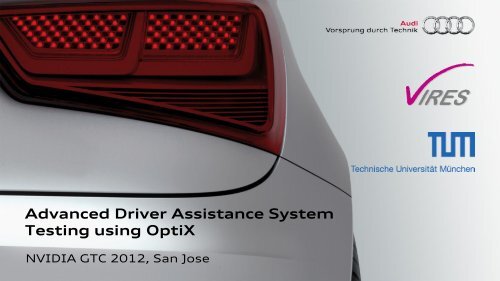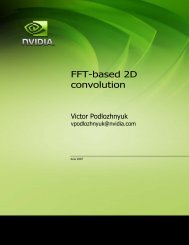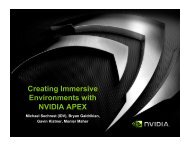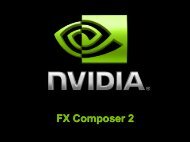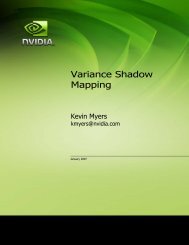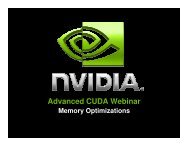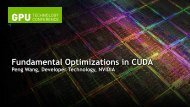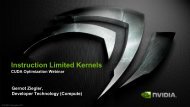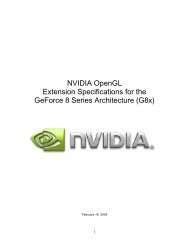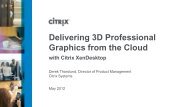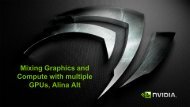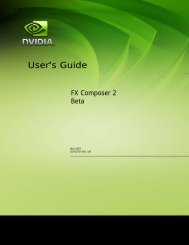Advanced Driver Assistance System Testing Using OptiX - Nvidia
Advanced Driver Assistance System Testing Using OptiX - Nvidia
Advanced Driver Assistance System Testing Using OptiX - Nvidia
You also want an ePaper? Increase the reach of your titles
YUMPU automatically turns print PDFs into web optimized ePapers that Google loves.
<strong>Advanced</strong> <strong>Driver</strong> <strong>Assistance</strong> <strong>System</strong><br />
<strong>Testing</strong> using <strong>OptiX</strong><br />
NVIDIA GTC 2012, San Jose
2<br />
<strong>Advanced</strong> <strong>Driver</strong> <strong>Assistance</strong> <strong>System</strong> <strong>Testing</strong> using <strong>OptiX</strong><br />
Erwin Roth<br />
Robotics and Embedded <strong>System</strong>s, Technischen Universität München<br />
Tugkan Calapoglu, Holger Helmich<br />
Vires Simulationstechnologie GmbH, Bad Aibling<br />
Kilian v. Neumann-Cosel<br />
Automotive Safety Technologies GmbH, Ingolstadt<br />
Marc-Oliver Fischer<br />
Department for Vehicle Safety Sensor Algorithms, AUDI AG, Ingolstadt<br />
Andreas Kern<br />
Audi Electronics Venture GmbH, Ingolstadt<br />
Andreas Heider, Alois Knoll<br />
Robotics and Embedded <strong>System</strong>s, Technische Universität München<br />
E. Roth, T. Calapoglu, et al.
3<br />
Agenda<br />
► Motivation, requirements and goals<br />
► Integration of <strong>OptiX</strong> into the Vires Virtual Test Drive simulation software<br />
► <strong>Advanced</strong> material and emitter data descriptions<br />
► Example sensor model implementations<br />
► Model validation and verification process<br />
► Summary and Outlook<br />
E. Roth, T. Calapoglu, et al.
4<br />
Motivation<br />
Growing challenges for testing new <strong>Advanced</strong> <strong>Driver</strong> <strong>Assistance</strong> <strong>System</strong>s (ADAS)<br />
► Increased number of comfort-, energy-management- and safety-related functions<br />
► Growing dependency of ADAS-functions on multiple perception sensors<br />
► Difficulties to record reproducible sensor data for real world scenarios<br />
Forecast: 300% increase in shipped ADAS units [Mio.]<br />
30<br />
20<br />
10<br />
0<br />
E. Roth, T. Calapoglu, et al.<br />
2012 2013 2014 2015 2016 2017<br />
Source: iSuppli
5<br />
Main Objectives<br />
• Support ADAS testing with computer simulations for realistic multi-sensor data computation<br />
• Validated sensor models as parts of an<br />
integrated vehicle and environment<br />
simulation system<br />
• Enable closed-loop simulations in Hardware- and Software-in-the-loop testbeds<br />
• Reproducibility of test scenarios for a wide range of environment and traffic conditions<br />
� Early evaluation of new sensor concepts and ADAS functions<br />
� Increased test space coverage by combining real and virtual test drives<br />
E. Roth, T. Calapoglu, et al.
6<br />
Multi-Sensor Simulation Environment Objectives<br />
• Simultaneous execution of multiple perception<br />
sensor emulators with realistic distortion effects<br />
• Share a common simulation infrastructure<br />
for sensor data consistency<br />
• Scenario description<br />
• Object, material and emitter (light) data<br />
• Communication<br />
• Configuration<br />
E. Roth, T. Calapoglu, et al.
7<br />
Sensor Emulator Requirements - Architecture<br />
• Support the same data formats and interfaces as the real sensor<br />
Simplified integration into the existing ADAS development and testing process<br />
E. Roth, T. Calapoglu, et al.
8<br />
Sensor Emulator Requirements – Simulation Variants<br />
• Support various simulation types in the existing ADAS test toolchain<br />
E. Roth, T. Calapoglu, et al.<br />
Toolchain for the integrated development and testing of ADAS functions<br />
Software-in-the-loop <strong>Driver</strong>-in-the-loop Vehicle-in-the-loop<br />
slower / faster<br />
than real-time<br />
+<br />
ADTF®<br />
(Automotive Data and Time<br />
Triggered Framework)<br />
soft real-time hard real-time<br />
real<br />
+<br />
virtuell<br />
Bock, EF-56<br />
MATLAB® &<br />
Simulink®<br />
Hardware-in-the-loop<br />
hard real-time
9<br />
Sensor Emulator Requirements – Level of Realism<br />
• Extensible architecture regarding refined models<br />
for a higher level of realism<br />
• Configurable approximation accuracy and distortion levels<br />
with a single consistent model<br />
E. Roth, T. Calapoglu, et al.<br />
ideal<br />
Algo. validation<br />
(SIL, faster than real-time)<br />
Sensor Emulation Data Accuracy<br />
‘functional realism’<br />
ADAS system testing<br />
(HIL, hard-real-time)<br />
‘close to reality’<br />
Operational-envelope<br />
testing (SIL, non-real-time)
10<br />
Sensor Emulator Requirements – Physics<br />
• Particle-, ray- and wave-based physical<br />
measurement methods shall be approximated<br />
• Physics-oriented modeling of<br />
• sensor data acquisition process<br />
• related systematic and stochastic distortion effects<br />
• material, surface and emitter properties<br />
E. Roth, T. Calapoglu, et al.<br />
Emitter<br />
Receiver<br />
Signal propagation<br />
[Source: Keller, Kolb]
11<br />
<strong>Advanced</strong> Material and Emitter Description<br />
Multi-modal sensor simulation requires extended<br />
material and light source (emitter) descriptions<br />
• Each material is identified by a unique ID<br />
• Covering also non-visible light spectrum, e.g. 300 – 1000nm<br />
• Holding meta data for material/emitter classification, lookup, …<br />
• Storage of physical properties in form of scalars and textures<br />
• Support for existing measurement techniques and<br />
material standards incl. accuracy information<br />
• Material data records must be extensible<br />
E. Roth, T. Calapoglu, et al.<br />
Unique Material ID<br />
Parent Material ID = Alloy<br />
Meta Data<br />
•Description = „Alloy 85‟<br />
•Class: Metal<br />
•Surface subclass: Coated<br />
•Measurement standard and accuracy info<br />
Physical Parameters [Si-Units]<br />
•Elec. Conductivity = 36.59 *10^6 S/m<br />
•Surface roughness = 120 um<br />
Diffuse Reflection Spectrum<br />
OpenGL Fallback Colors<br />
Software specific shaders / RT programs<br />
Measured BRDF/BSDF/BTF<br />
for visible, infrared, … spectrum<br />
Extended data
12<br />
Integration of <strong>OptiX</strong> and VTD
13<br />
Virtual Test Drive<br />
Mockup<br />
Scenario<br />
Editor<br />
Road<br />
Designer<br />
ROD<br />
Traffic<br />
Configuration<br />
Sound<br />
3D renderer<br />
v-IG<br />
Task and Data<br />
Control<br />
Mockup<br />
Open Interfaces<br />
Operator<br />
Station<br />
3rd Party<br />
Components<br />
<strong>System</strong>s<br />
Module<br />
Manager<br />
Vehicle<br />
Dynamics<br />
<strong>Driver</strong><br />
Model<br />
<strong>System</strong>s<br />
Dynamics<br />
Sensors<br />
• VTD core = simulation environment<br />
• 3D rendering (image generator)<br />
• traffic and scenario<br />
• sound<br />
• mockup interfaces<br />
• record/playback<br />
• event and data handling<br />
• content creation<br />
• management of custom modules<br />
• VTD dev = development environment<br />
• interfaces for<br />
•run-time data (Run-time Data Bus – RDB)<br />
•event / control data (Simulation Control<br />
Protocol – SCP)<br />
•sensor development<br />
(using Image Generator v-IG)<br />
• module development via<br />
• library<br />
• C++ API
14<br />
VTD – Content Creation Toolchain<br />
Content Creation<br />
IOS<br />
(Project Edit Mode)<br />
Runtime<br />
Project<br />
IOS<br />
Scenario<br />
Description<br />
Scenario<br />
Editor<br />
Traffic<br />
Road logic and<br />
Geometry<br />
TaskControl<br />
ROD<br />
(Road Designer)<br />
Vehicle<br />
Dynamics<br />
Visual<br />
Database<br />
v-IG<br />
(3D renderer)<br />
Content data<br />
Real-time data
15<br />
v-IG<br />
• Open Scene Graph (and OpenGL) based 3D<br />
renderer<br />
• Part of VTD but also available as<br />
a standalone renderer<br />
• Provides an API<br />
• Used in driving, train and flight simulators<br />
• Used in sensor simulation applications<br />
Sensor image for hardware-in-the-loop simulator (OpenGL)<br />
Standard day scene (OpenGL)<br />
HDR night scene with wet road (OpenGL)
16<br />
<strong>OptiX</strong> plug-in<br />
• Conversion of OSG scene to <strong>OptiX</strong> scene<br />
– Geometry, Materials<br />
• Synchronizing OSG/<strong>OptiX</strong> scenes<br />
– Animations, LOD, Lights<br />
• Post Processing<br />
• Real-time data transfer<br />
• C++ API provided for customization<br />
• New camera models with<br />
Cuda/C++<br />
• Different buffer formats,<br />
multiple output buffers<br />
• Custom light sources<br />
• Building post processing<br />
pipelines<br />
• Adding/editing materials
17<br />
Creating the <strong>OptiX</strong> node graph<br />
• v-IG loads the scene and creates an OSG scene graph<br />
• <strong>OptiX</strong> plug-in translates the OSG scene graph to an <strong>OptiX</strong> scene graph<br />
• <strong>OptiX</strong> specific optimizations during translation<br />
• Some objects (e.g. Vehicles) loaded and deleted in run-time<br />
v-IG<br />
Materials<br />
OSG scene graph<br />
Terrain,<br />
3D models<br />
<strong>OptiX</strong> plug-in translates<br />
the scene graph to<br />
<strong>OptiX</strong> node graph<br />
<strong>OptiX</strong> node graph
18<br />
Material management<br />
• XML material definitions<br />
• Grouped according to<br />
wavelength and/or sensor<br />
type<br />
Materials<br />
IR<br />
Radar<br />
• Associates materials with<br />
objects<br />
• Grouped according to<br />
wavelength and/or sensor<br />
type<br />
Assignments<br />
IR<br />
Radar<br />
• Identified by textures or<br />
ID„s<br />
• v-IG assigns the materials<br />
to OSG scene graph nodes<br />
• <strong>OptiX</strong> plug-in creates <strong>OptiX</strong><br />
materials and puts into the<br />
material buffer<br />
Scene Objects
19<br />
Material Management<br />
• Material definitions in XML<br />
• Common materials for rasterizer and<br />
ray-tracer<br />
– Shader params will be GLSL<br />
uniforms in rasterizer and <strong>OptiX</strong><br />
variables in ray-tracer<br />
– Rasterizer loads GLSL programs,<br />
<strong>OptiX</strong> ptx files<br />
• New materials can be derived from<br />
existing ones<br />
Sample material decleration<br />
<br />
<br />
<br />
<br />
<br />
<br />
<br />
<br />
Copy and override material properties<br />
<br />
<br />
20<br />
Synchronization of scenes<br />
• v-IG manipulates OSG scene graph nodes (e.g. DOF´s) for animations<br />
• LOD nodes are automatically updated by OSG<br />
• <strong>OptiX</strong> plug-in monitors function nodes and synchronizes their <strong>OptiX</strong><br />
counterparts<br />
Simulation<br />
Animation data<br />
over network<br />
• Camera<br />
position<br />
• Positions and<br />
orientation of<br />
objects<br />
• Light positions<br />
• Etc.<br />
v-IG<br />
Animation<br />
routines<br />
v-IG<br />
manipulates<br />
the scene<br />
graph to<br />
animate the<br />
objects<br />
OSG scene graph<br />
<strong>OptiX</strong> plug-in<br />
synchronizes the<br />
graphs<br />
continuously<br />
<strong>OptiX</strong> node graph
21<br />
Lights and emitters<br />
• v-IG creates and manages a list of lights<br />
– Some lights are generated automatically with the information<br />
stored in the terrain and models (car headlights, street lamps)<br />
– Communication protocol allows for creating and controlling lights<br />
externally<br />
• <strong>OptiX</strong> plug-in synchronizes <strong>OptiX</strong> light buffer with v-IG lights<br />
• Lights can represent any type of emitter<br />
Simulation<br />
Animation data<br />
over network<br />
• Positions and<br />
orientation of<br />
objects<br />
• Light positions<br />
v-IG<br />
Light<br />
control<br />
Object<br />
animation<br />
routines<br />
Update lights that<br />
are created and<br />
managed by<br />
external<br />
applications<br />
Update lights that<br />
are parts of<br />
simulation entities<br />
(e.g. Car<br />
headlights)<br />
v-IG<br />
Lights<br />
<strong>OptiX</strong> plug-in<br />
synchronizes the<br />
lists continuously<br />
<strong>OptiX</strong> light buffer
22<br />
Post processing<br />
• Rendered buffers can be fed into v-IG post<br />
processing pipeline<br />
– Programmable through API<br />
– Post processing with GLSL shaders<br />
– 32 bit floating point<br />
• Motivations<br />
– Bloom<br />
– Noise<br />
– Tone mapping<br />
– Etc.<br />
<strong>OptiX</strong> plug-in<br />
32-bit float<br />
<strong>OptiX</strong> output<br />
buffer<br />
32-bit float<br />
OpenGL<br />
texture<br />
...<br />
Post processing step 1<br />
32-bit float<br />
OpenGL<br />
texture<br />
Tone mapping and blooming<br />
Post processing step n
23<br />
Real-time data transfer<br />
• Rendered buffers are made available to external applications<br />
• Shared memory or network<br />
• Producing data for hardware-in-the-loop and software-in-the-loop simulations<br />
Other<br />
workstation(s)<br />
or<br />
sensor hardware<br />
Network<br />
RAM<br />
v-IG + <strong>OptiX</strong><br />
Shared<br />
Memory<br />
User application<br />
Video<br />
RAM<br />
32-bit float<br />
<strong>OptiX</strong> output<br />
buffer<br />
32-bit OpenGL<br />
texture<br />
...<br />
32-bit OpenGL<br />
texture<br />
Post processing
24<br />
Sensor Model Examples<br />
using <strong>OptiX</strong> + VTD
25<br />
Photonic Mixing Device (PMD) Sensor Model<br />
• The PMD-sensor uses the Time-of-Flight principle<br />
for measuring intensity and depth data of a 3D-scene<br />
with modulated infrared (IR) light<br />
• Important systematic and stochastic distortion effects<br />
• non-ambiguity range<br />
• extraneous light sensitivity<br />
• “flying pixels”, motion blur<br />
• Three-step sensor data simulation<br />
E. Roth, T. Calapoglu, et al.<br />
colorized depth-image<br />
[Source: Keller, Kolb]
PMD Sensor Model<br />
• Approximation techniques in the current PMD sensor emulator<br />
• Multiple rays per pixel with stratified sampling<br />
• Simulate the angle-dependent emission characteristics of<br />
26 E. Roth, T. Calapoglu, et al.<br />
the modulated IR-light source based on Radiometry measurements<br />
• Phong reflection model in combination with<br />
measured IR-material reflection values
27<br />
Ultrasonic Sensor Model<br />
• Currently: ideal acoustic wave propagation model<br />
• Modeling requirements<br />
• Computation of primary-, secondary and cross-echo<br />
• Efficient computation of up to 20 ultrasonic sensors<br />
on a single GPU<br />
• Consideration of target object material class (e.g. vegetation)<br />
E. Roth, T. Calapoglu, et al.<br />
Test scene in MATLAB<br />
16 circularly-arranged ultrasonic sensor „depth maps“ simultaneously rendered with <strong>OptiX</strong>
28<br />
Sensor Emulator Validation and Verification Stages<br />
Real Sensor <strong>System</strong><br />
Raw data<br />
Processing<br />
Raw data<br />
Generation<br />
Raw data<br />
Generation<br />
Objectification<br />
Algorithms<br />
<strong>OptiX</strong> + ADTF<br />
Sensor Emulator<br />
Objectification<br />
Algorithms<br />
MATLAB + ADTF<br />
Sensor Emulator<br />
E. Roth, T. Calapoglu, et al.<br />
Objectification<br />
Algorithms<br />
� Sensor test bench<br />
� Real test drive<br />
� Issue recordings DB<br />
Real-time capable<br />
� x-in-the-loop variants<br />
Non-real-time,<br />
high fidelity<br />
� MATLAB ray-tracer for<br />
raw data generation<br />
2. Verification<br />
<strong>Testing</strong> with<br />
real sensor data<br />
1. Validation<br />
Prototypical<br />
<strong>Testing</strong><br />
Comparison<br />
based on reference<br />
data & virtual<br />
scene generation<br />
Comparison<br />
based on static + dyn.<br />
description of<br />
„analytical scenes“<br />
using XML
Sensor Emulator Validation and Verification Toolchain<br />
v-IG<br />
Vehicle Dynamics<br />
Traffic<br />
…<br />
ADTF<br />
Sensor Objectification Algorithms<br />
Sensor Objectification Algorithms<br />
ADAS Algorithms<br />
ADAS Algorithms<br />
Real sensor data recordings<br />
incl. reference- and scenario-data<br />
29 E. Roth, T. Calapoglu, et al.<br />
Sensor-Plugin<br />
<strong>OptiX</strong> - API<br />
Objects<br />
Material<br />
state data<br />
raw data<br />
actuator<br />
data<br />
Shared Memory or Network<br />
Simulink<br />
� Master Control Unit<br />
� Closed-loop Model<br />
MATLAB<br />
offline data comparison<br />
scenario#1: per frame data<br />
real synth.<br />
scenario#N: per frame data<br />
real synth.<br />
ground-<br />
truth<br />
ground-<br />
truth
30<br />
Summary<br />
► We showed our approach for supporting ADAS algorithm and function testing<br />
by using Virtual Test Drive and <strong>OptiX</strong> for multi-sensor data simulation<br />
► Related requirements and implemented concepts for realistic multi-sensor simulation<br />
► Physics-oriented sensor modeling using <strong>OptiX</strong><br />
► A common sensor-model simulation infrastructure<br />
► <strong>Advanced</strong> material and emitter specifications<br />
► Validation and verification process<br />
► Ray-tracing with <strong>OptiX</strong> seems to be a reasonable<br />
platform. However, we are just at the beginning …<br />
E. Roth, T. Calapoglu, et al.<br />
AUDI ADAS Demonstrator
Outlook<br />
Challenges to be tackled in the future regarding …<br />
► A standard for multi-spectral material and emitter specifications<br />
► Simulation software independent description and identification scheme<br />
► Physical property handling of materials and emitters, e.g. for wavelengths 300 – 1000nm<br />
► Support for different measurement data formats and standards<br />
► <strong>OptiX</strong><br />
► Support for large scenarios (1000x of objects, 100x materials, 10x sensor models, …)<br />
► Improved multi-GPU scalability for 60 Hz and higher<br />
► Improved <strong>OptiX</strong> debugging, profiling and optimization tools<br />
31 E. Roth, T. Calapoglu, et al.
32<br />
Vielen Dank.<br />
Contact:<br />
E. Roth, T. Calapoglu, et al.<br />
Get in touch with us, if you are<br />
also using <strong>OptiX</strong> for sensor simulation!<br />
Erwin Roth, Technische Universität München<br />
erwin.roth@in.tum.de<br />
Tugkan Calapoglu, Vires Simulationstechnologie GmbH<br />
tugkan@vires.com<br />
Thank you very much.
33 E. Roth, T. Calapoglu, et al.<br />
BACKUP
34<br />
Why was NVIDIA <strong>OptiX</strong> selected?<br />
• Since Intel‟s Larrabee was never released ;-)<br />
• Programmability and Flexibility of <strong>OptiX</strong>‟s Ray Tracing pipeline<br />
• Customizable Ray Tracing pipeline<br />
• Focus on mathematical model rather than 3D programming<br />
• Many core, multi-GPU scalability<br />
• Availability for different platforms<br />
• AUDI was already using the Virtual Test Drive (VTD) simulation system<br />
• We decided to extend the OpenSceneGraph-based 3D-renderer of VTD with an <strong>OptiX</strong>-plugin<br />
• Allows us to reuse most of the existing rendering and simulation infrastructure<br />
E. Roth, T. Calapoglu, et al.<br />
[Source: NVIDIA]
XML-Scene Data Interchange Format<br />
• File format for <strong>OptiX</strong> node graphs<br />
– XML based format<br />
– Easily readable and editable<br />
– C++ library for loading/saving<br />
– Can be integrated to other<br />
software<br />
• Motivations<br />
– Sensor model validation<br />
– Debugging<br />
35 E. Roth, T. Calapoglu, et al.
36<br />
Integrated Material Handling<br />
CAD <strong>System</strong><br />
� Design of geometry<br />
� Initial material<br />
assignment<br />
Material<br />
translator<br />
<strong>Advanced</strong> Material<br />
E. Roth, T. Calapoglu, et al.<br />
Reference DB<br />
with GUMID<br />
Geometry<br />
Data<br />
+<br />
Global<br />
Unique<br />
Material ID<br />
(GUMID)<br />
PDM <strong>System</strong><br />
� Central data<br />
management<br />
Organization-wide<br />
<strong>Advanced</strong> Material +<br />
Emitter DB<br />
with GUMID<br />
GUMID concept based on<br />
Gerd Sussner, RTT AG<br />
Material<br />
Material<br />
translator<br />
Material<br />
translator<br />
Measurement Labs<br />
Manufacturing<br />
High End Visualization<br />
RTTDeltagen, Maya, …<br />
Simulation<br />
VTD, FEM-crash, -thermo, …
Multi-Sensor Simulation Material pre-processing Pipeline<br />
Geometry<br />
data incl.<br />
geometry IDs<br />
Level:<br />
Sim.<br />
Environment<br />
MA<br />
assignment<br />
table<br />
<strong>Advanced</strong><br />
Material + Emitter<br />
Reference DB<br />
37 E. Roth, T. Calapoglu, et al.<br />
Road-<br />
surface<br />
model<br />
Level:<br />
Organization<br />
MA<br />
assignment<br />
table<br />
Simulation<br />
Environment Vendor<br />
Material + Emitter DB<br />
High polygon vehicle models<br />
Optimized polygon vehicle meta models<br />
Level:<br />
Test Scenario<br />
MA<br />
assignment<br />
table<br />
Organization-wide<br />
<strong>Advanced</strong> Material +<br />
Emitter DB<br />
Test<br />
Scenario<br />
Level:<br />
Sensor Model<br />
MA<br />
assignment<br />
table<br />
Offline<br />
pre-processing<br />
stage<br />
Simulator<br />
Environment<br />
Offline<br />
pre-processed<br />
material +<br />
emitter data<br />
-> optimized for<br />
simulation engine<br />
Offline<br />
pre-processed<br />
Vehicle Models
38<br />
<strong>Advanced</strong> Emitter Description<br />
• Simulating interference effects on sensors requires models<br />
of ego- and extraneous-emitters<br />
• Examples for emitters:<br />
• Vehicle headlights, traffic lights, street lamps<br />
• Emitters of active sensors (RADAR, Infrared light source, …)<br />
• Car2X-Transmitters<br />
• Related emission characteristics should be stored in physically<br />
measurable SI units using Radiometry in order to not cover<br />
the visible light spectrum only<br />
• The specific emitter characteristics should be stored in an<br />
organization-wide database with a unique emitter ID<br />
E. Roth, T. Calapoglu, et al.<br />
Unique Emitter ID<br />
Parent Emitter ID =<br />
Meta Data<br />
•Brief description<br />
•Class: ‚Vehicle Headlight„<br />
•Emission spectrum: min, max<br />
•State flags<br />
•Number of sub-emitters: 2<br />
•Sub-Emitter1<br />
•Position, Orientation<br />
relative to Ref. Coord. Sys.<br />
•Number of state profiles = 3<br />
•State-Profile1<br />
•Emission map Format<br />
•Emission map data<br />
•State-Profile2<br />
•…<br />
•Sub-Emitter2<br />
OpenGL fallback<br />
illumination model<br />
•Frustum data<br />
•Phong intensity data<br />
•Attenuation


